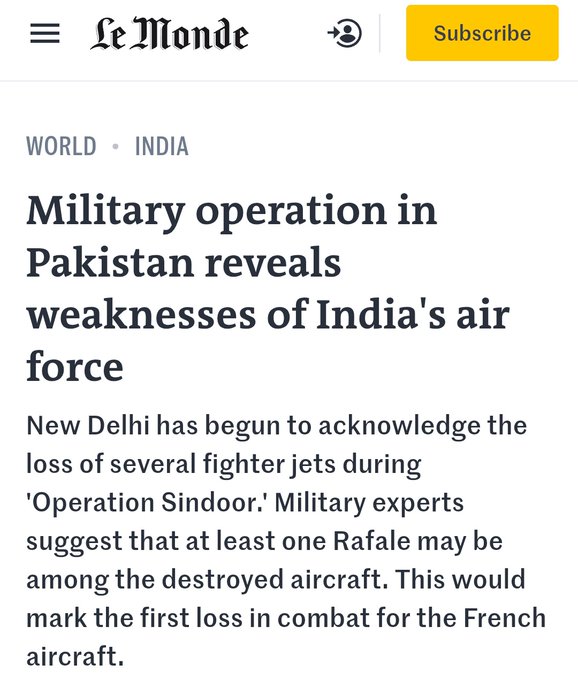See other World News Articles
Title: Pakistani air victory raises alarms for Taiwan’s defense strategy
Source:
https://x.com/Defence_PK99/status/1920683230019166222
URL Source: https://citizenwatchreport.com/paki ... -for-taiwans-defense-strategy/
Published: May 9, 2025
Author: Horse
Post Date: 2025-05-09 19:32:10 by Horse
Keywords: None
Views: 184
Defence Pakistan @Defence_PK99 #BREAKING: A French media outlet has confirmed that at least one IAF Dassault Rafale has been shot down by the Pakistan Air Force. Pakistan’s recent air combat success over India has sent shockwaves through global military strategy discussions, particularly regarding Taiwan’s defense posture. In the skies above the contested Kashmir region, Pakistani fighters using older models like the J-10C, equipped with PL-15 and HQ-9 missiles, brought down multiple Indian Rafale jets. The distance at which this occurred, 160 km, raised eyebrows worldwide. These systems, considered one or two generations behind China’s most advanced technologies, still managed to outperform one of the world’s most cutting-edge fighters. Taiwan’s geographic vulnerability is impossible to ignore. The Taiwan Strait, only 180 km wide, leaves the island within striking distance of advanced Chinese military systems. If the Chinese PLA Air Force has more advanced weaponry than the J-10C and PL-15, systems already proven to be effective, it could quickly dominate the skies over Taiwan. The results would be disastrous. Taiwan’s air force relies on fighter jets like the French Rafale, which is comparable to the best aircraft the island could acquire. But that’s not the whole story. The real threat lies in the integration of China’s military systems, which outclass Taiwan’s fragmented arsenal. Taiwanese media is beginning to sound alarm bells. They are scrutinizing Pakistan’s success and questioning whether their current defense strategy is still viable in the face of such overwhelming air superiority. Indian military hardware, which includes the Rafale jet, should be superior to Pakistan’s aging fleet, but it wasn’t. The issue lies not in the quality of the individual systems but in the integration of these systems into a cohesive, synchronized network. India’s arsenal is a patchwork of Russian, French, American, and Israeli technologies. While these systems are impressive on their own, they lack seamless integration. Information does not flow as fluidly between them, and communication gaps leave critical vulnerabilities. In contrast, China’s military systems are purposefully designed for seamless integration. The PLA’s technology shares data across platforms, giving them an overwhelming advantage in terms of situational awareness and rapid decision-making. This integrated approach makes a low-cost system, like the J-10C, able to neutralize far superior hardware on paper. The Indian arsenal, with its mixture of uncoordinated equipment, is more vulnerable to a well-coordinated, singularly focused adversary like China. The implications for Taiwan are dire. With the same basic air defense challenges faced by India, superior technology not fully harnessed in an integrated system, Taiwan’s defense strategy may soon be obsolete. The real test isn’t whether Taiwan’s fighters are technically capable, but whether they can function as part of a cohesive, unified defense system against a far more advanced, integrated Chinese military. Taiwan’s current defense doctrine could be on the brink of collapse in the face of this strategic reality. Poster Comment: That HQ 9 missile was created by China based on the US Patriot missile which was sold by Israel to China. The Chinese crossed it with the Russian S-300 to make the HQ 9. This means not just Taiwan but Israel is toast if they attack Iran. That means we can cut the US defense budget in half, audit the FED and the DOD, seize the FED and balance our budget saving us from disaster. 
Post Comment Private Reply Ignore Thread